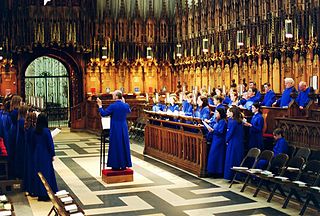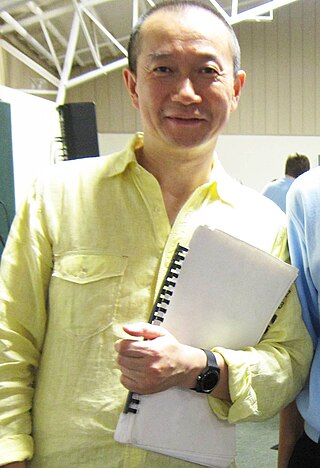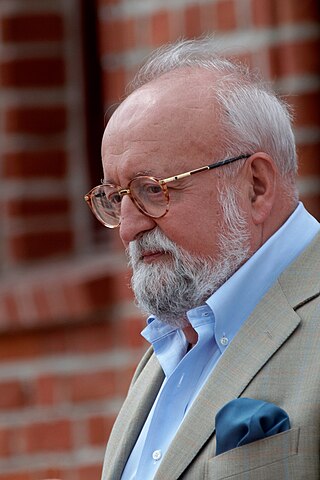Related Research Articles

An orchestra is a large instrumental ensemble typical of classical music, which combines instruments from different families. There are typically four main sections of instruments:

A choir is a musical ensemble of singers. Choral music, in turn, is the music written specifically for such an ensemble to perform or in other words is the music performed by the ensemble. Choirs may perform music from the classical music repertoire, which spans from the medieval era to the present, or popular music repertoire. Most choirs are led by a conductor, who leads the performances with arm, hand, and facial gestures.

As it is a country with many different tribes and ethnic groups, the music of Indonesia itself is also very diverse, coming in hundreds of different forms and styles. Every region has its own culture and art, and as a result traditional music from area to area also uniquely differs from one another. For example, each traditional music are often accompanied by their very own dance and theatre. Contemporary music scene have also been heavily shaped by various foreign influences, such as America, Britain, Japan, Korea, and India.
The music of the Philippines includes the musical performance arts in the Philippines and the music of Filipinos composed in various local and international genres and styles. Philippine musical compositions are often a mixture of Indigenous styles, and various Asian styles, as well as Spanish/Latin American and (US) American influences through foreign rule from those countries.

Evan Ziporyn is an American composer of post-minimalist music with a cross-cultural orientation, drawing equally from classical music, avant-garde, various world music traditions, and jazz. Ziporyn has composed for a wide range of ensembles, including symphony orchestras, wind ensembles, many types of chamber groups, and solo works, sometimes involving electronics. Balinese gamelan, for which he has composed numerous works, has compositions. He is known for his solo performances on clarinet and bass clarinet; additionally, Ziporyn plays gender wayang and other Balinese instruments, saxophones, piano & keyboards, EWI, and Shona mbira.

Tan Dun is a Chinese-born American composer and conductor. A leading figure of contemporary classical music, he draws from a variety of Western and Chinese influences, a dichotomy which has shaped much of his life and music. Having collaborated with leading orchestras around the world, Tan is the recipient of numerous awards, including a Grawemeyer Award for his opera Marco Polo (1996) and both an Academy Award and Grammy Award for his film score in Ang Lee's Crouching Tiger, Hidden Dragon (2000). His oeuvre as a whole includes operas, orchestral, vocal, chamber, solo and film scores, as well as genres that Tan terms "organic music" and "music ritual."

Nikolai Sergeevich Korndorf was a Russian and Canadian composer and conductor. He was prolific both in Moscow, Russia, and in Vancouver, British Columbia, Canada.

Virko Baley is a Ukrainian-American composer, conductor, and pianist. He was born in Radekhiv in Poland, the only child of Petro (Peter) and Lydia Baley. Petro Baley was interred at Auschwitz concentration camp following the German invasion of Poland in 1939, and he and extended family were relocated to Slovakia. The family was reunited on a farm in Germany towards the end of the war to work as farm laborers, after which they relocated to Munich. From 1947 to 1949, the family lived in a displaced person's camp in Regensburg, Germany.

Philippe Maria François Herreweghe, Knight Herreweghe is a Belgian conductor and choirmaster.

Polish Requiem, also A Polish Requiem, is a large-scale requiem mass for soloists, mixed choir and orchestra by the Polish composer Krzysztof Penderecki. The Lacrimosa, dedicated to the trade union leader Lech Wałęsa, was written for the unveiling of a statue at the Gdańsk Shipyard to commemorate those killed in the Polish anti-government riots in 1970. He expanded the work into a requiem, writing other parts to honour different patriotic events over the next four years.

Melinda O'Neal is a conductor of choral and choral-orchestral music, professor emerita of music, and author.

Richard Marriott is an American composer and performer. He has composed for film, television, dance, theater, opera, installations and video games. He is the founder and artistic director of the Club Foot Orchestra, an important modern ensemble for live music performance with silent films. His teachers include Dominick Argento and Paul Fetler at the University of Minnesota, Pauline Oliveros at UCSD, North Indian sarod master Ali Akbar Khan, shakuhachi master Masayuki Koga, and Balinese composers Nyoman Windha and Made Subandi. Marriott was a member of Snakefinger's History of the Blues and has recorded with The Residents, Brazilian Girls, "Singer at Large" Johnny J. Blair, and many others. He performs on brass and woodwind instruments, Western and Asian.
Jeffrey Ching is a contemporary classical composer. He was born in the Philippines, to Chinese parents. He is married with the operatic soprano Andión Fernández and has two children.
Souvenir des Ming is the title of Jeffrey Ching's Fourth Symphony, which was composed in London between 14 January and 29 June 2002, and is in a single large movement lasting about thirty-five minutes. There is a further parenthetical title, Passacaglia and Fugue on Ming dynasty Fragments, which describes the actual thematic content and form of the work. In China the work is known as Minglü huiyin 明律回音.
Terra Kytaorum is a work for brass ensemble and percussion by the contemporary classical composer Jeffrey Ching. Its subtitle is Souvenir des Yuan, which incorporates it into that composer's series of musical souvenirs based on melodic material from various Chinese dynasties: Souvenir des Tang (1997), Souvenir des Song (1994), and Souvenir des Ming (2002). The present work was completed in London on 31 December 2000.
Ruth Bakke is a Norwegian organist and composer. She was born in Bergen, Norway, and studied at the Bergen Music Conservatory and the University of Oslo. She continued her studies on a Fulbright grant at Converse College in South Carolina, Texas Lutheran College, University of Redlands in California, and Washington State University.

Mit Fried und Freud, BuxWV 76, is the common name for a piece of funeral music composed by Dieterich Buxtehude as an homage to his father in 1674. The composer named the work Fried- und Freudenreiche Hinfarth when he published it the same year. It is a bundle of two compositions, the earlier Mit Fried und Freud, BuxWV 76a, a setting of Luther's hymn Mit Fried und Freud ich fahr dahin composed in 1671 reflecting the death of Menno Hanneken, and the elegy Klag-Lied, BuxWV 76b, an aria in seven stanzas. The incipit of the elegy, "Muß der Tod denn auch entbinden", translates roughly to "Even if death must separate us". It is one of few compositions published during Buxtehude's lifetime.